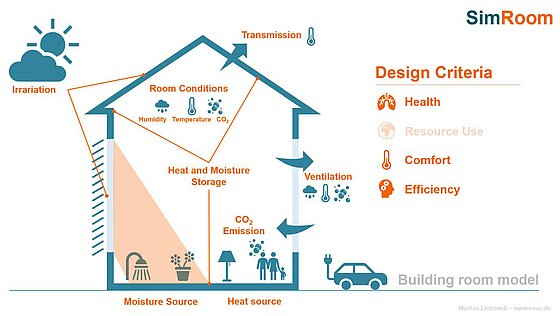Summer thermal comfort

© M. Lichtmeß
Maintaining indoor comfort that meets the occupant’s expectations is one of the major efforts in building design, construction and operation. The reason is that in most locations in the world, the typical outdoor conditions are more or less far from thermal comfort as defined in typical comfort expectations. On the other hand, expectations of peoples are changing. Example are the rising need for cooling due to increased income in the fast economic growing countries of the world and the introduction of air conditioning as standard in private cars. It is a current major task to reduce energy use in buildings, while at the same time providing comfortable indoor environments for the occupants. This is especially true for the summer indoor climate under the influence of climate change.
In most climates, the temperature is in the focus of thermal comfort. The relative humidity gains importance in connection with high temperatures. Air quality is typically addressed with CO2-concentration analysis. The topic has a major relevance in the discussion on low energy buildings due to increased air tightness of building envelopes and the performance of fan assisted ventilation systems.
Indoor comfort is always addressed in an own discipline within the Solar Decathlon. It was mostly associated with a maximum of 100 points and fully based on monitoring data. Typically, two rooms are observed per house. Starting in 2014 thermal comfort in Solar Decathlon Europe is evaluated according to the adaptive thermal comfort model based on DIN EN 15251:2012.
Typically, teams in the Solar Decathlon address indoor comfort during the planning by dynamic building simulation. In SDE 21/22, all teams work with the single zoon modelling tool “SimRoom” and simulation results will be compared to monitored data to research the performance gap. SimRoom was developed by Markus Lichtmeß with a special focus on education of architects and engineers. Students can benefit from free versions.
Further reading
- Voss; Rizaoglu; Balcerzak; Hansen: Solar Decathlon Europe 2022 - Perspektiven für nachhaltiges Bauen anhand der bauphysikalischen Ergebnisse von Demonstrationsgebäuden, in: Bauphysikkalender 2023, 2023, https://www.sciencedirect.com/science/article/pii/S0378778823001214
- Lichtmeß, M.: SimRoom – Dynamic analysis of the room temperature, room humidity and the air quality as well as the energy balance of a one-zone model, user manual, 2021, https://ingefo.de/Werkzeuge/SimRoom
